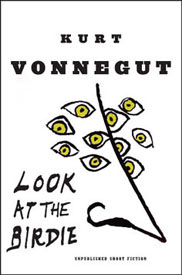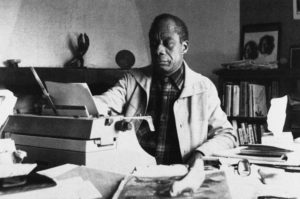Jane Ciabattari on Kurt Vonnegut
A wondrous new collection of previously unpublished vintage Vonnegut confirms his enduring and subversive ear for the absurd and the tragicomic.
Occasionally from the nation’s cultural attic come rare finds — last touches of genius brought to light — like this wondrous new collection of vintage Kurt Vonnegut short stories. “Look at the Birdie” includes 14 previously unpublished short stories that were written in the years just following World War II, when Vonnegut was back home after witnessing the firebombing of Dresden as a prisoner of war.
The stories are accompanied by Vonnegut’s own whimsical line drawings, and introduced by Vonnegut’s longtime tennis partner, best friend and literary man about New York, Sidney Offit, who is involved now in compiling a future Library of America Vonnegut volume. In the 1950s and early ’60s, Offit notes, Vonnegut had a growing family to support and published regularly in The Saturday Evening Post, Collier’s, Cosmopolitan, Argosy. “Hemingway! Fitzgerald! Faulkner! Steinbeck! Vonnegut!” Offit writes. “Their literary legacies survived the demise of so many of the magazines that provided them with generous fees, per word or per line, and introduced them to hundreds of thousands, even millions of readers.”
Why were these stories, with their lean language and supercharged imaginative range, unpublished? Offit speculates they were probably never submitted, as Vonnegut was always revising. “He was a master craftsman, demanding of himself perfection of the story, the sentence, the word. I remember the rolled up balls of paper in the wastebaskets of his workrooms in Bridgehampton and on East Forty-eighth Street.”
By midcentury, when he was writing these stories, Vonnegut was just beginning to publish. In 1950 he sold his first short story, “Report on the Barnhouse Effect,” to Knox Burger, then fiction editor at Collier’s, for $750 — six weeks’ pay at the PR job he had at GE. After Vonnegut sold a second story, Burger urged him to quit his job. In 1952 Vonnegut published his dystopian first novel, “Player Piano,” which drew in part on his graduate work in anthropology at the University of Chicago. By 1969 he had entered the literary lexicon with the Vietnam-era anti-war classic “Slaughterhouse Five.”
In fact, Vonnegut has become such a literary icon that it is surprising — indeed humanizing — to read the letter that opens this volume. This is the nervous young father Vonnegut writing to his friend Walter J. Miller back in 1951, five weeks after leaving his GE job to write full time, justifying his choice to write what he called “high-grade, slick bombast” for the slicks. The alternative, Vonnegut wrote, was “something to please The Atlantic, Harpers, or The New Yorker. To do this would be to turn out something after the fashion of somebody-or-other. … The kicks are based largely on having passed off a credible counterfeit. … This is poor competition for the fat checks from the slicks.”
Vonnegut aimed to publish regularly in the publications his mother, before her suicide in 1944, had hoped to crack. “She was a good writer, it turned out, but she had no talent for the vulgarity the slick magazines required,” he said in an interview published in Paris Review in 1977. “Fortunately, I was loaded with vulgarity, so when I grew up I was able to make her dream come true. Writing for Collier’s and The Saturday Evening Post and Cosmopolitan and Ladies’ Home Journal and so on was as easy as falling off a log for me. I only wish she’d lived to see it.”
|
To see long excerpts from “Look at the Birdie,” click here. |
Most of the stories in this collection display Vonnegut’s inimitable sense of the absurd and his tragicomic voice. They are fully formed and polished, with a quick setup (husbands and wives are popular in this mix), a surreal or sci-fi undertone, and a twist at the end. There is a Midwestern quality to Vonnegut’s storytelling (he was, after all, born and raised in Indianapolis) — accessible, plainspoken, with a straight-faced irony.
The noirish title story is neatly constructed in a variation on the “man walked into a bar” plot. The opening lines: “I was sitting in a bar one night, talking rather loudly about a person I hated—and a man with a beard sat down beside me, and he said amiably, ‘Why don’t you have him killed.’ ” Before long the bearded man has drawn out the narrator, and his wife/accomplice, “a scrawny, thin-lipped woman with raddled hair and bad teeth,” has aimed a Rolleiflex with a flashgun at him and said “Look at the …” you know what. And so proceeds a slick bit of blackmail by a “murder counselor.” “Confido” has echoes of Cheever’s 1953 story “The Enormous Radio” in its dark scenario of a new technology unmasking the politesse of post-World War II America. Henry, a company man, has found his ticket out of the Accousti-gem Corp. by inventing a device that listens to your innermost thoughts and responds. It’s “a small tin box, a wire, and an earphone, like a hearing aid, a creation, in its own modern way, as marvelous as Niagara Falls or the Sphinx.” Ellen, his wife, has dubbed it “Confido” — a combo confidant and household pet. Confido is somebody to talk to. Ellen gives it a try while Henry is heading to work to resign, and after hearing the insinuating voice trashing her friends and neighbors for several hours, decides it’s a bad idea. But Henry is hard to persuade this is not the way to get rich. “It’s bigger than television and psychoanalysis combined,” he says.
“Shout About It From the Housetops” is a set piece probably inspired by the scandalous publication of Grace Metalious’ “Peyton Place.” The story introduces Elsie Strang Morgan, author of a raw book about Hypocrite’s Junction (but really Crocker’s Falls) and her husband, Lance Magnum, from the perspective of a man selling aluminum storm windows. Her book leads to marital discord, resolved by the narrator, who, in a neat wrap-up, has the last word.
In “Hello, Red,” Red Mayo, a young man injured at sea, returns to his hometown to serve as a bridge tender. Vonnegut’s concise description is all we need to know about Red: “He was a heavy young man, twenty-eight, with the flat mean face of a butcher boy.” Red discovers his now deceased former girlfriend had a daughter he can see is his by her vivid red hair. Vonnegut captures Red’s pain as he makes a stumbling attempt at a showdown with Eddie, the man the 8-year-old thinks is her father, while giving equal time to Eddie’s trembling dignity as he claims he’s more her father than Red is. One of the locals who witnesses the scene in a coffee shop delivers the zinger at the end.
“King and Queen of the Universe,” set in 1932, during the Great Depression, follows a well-to-do young engaged couple, age 17, as they leave a dance and walk across a city park, fantasizing about being hobos. Real life pops up in a surreal fashion: “In the middle of the park, what seemed to be a gargoyle on the rim of a fountain detached itself. It revealed itself as a man.” At first frightened, the two are gradually drawn into an intimate and transforming encounter with the man and his mother. Vonnegut’s acute sense of social masks and hypocrisy is undergirded with compassion even for those naive or arrogant enough to be blind to human connection.
The last story in the collection, “The Good Explainer,” is a shaggy dog story about a husband and wife who travel from a small town outside Cincinnati to Chicago to visit a fertility expert. The pacing and intricately structured revelations deliver a whammo ending.
Reading “Look at the Birdie” is a bit like watching “Mad Man” on TV, with the added knowledge that the stories are of their time, not re-creations. The line-by-line mastery evident in these early stories provides a precious glimpse of a writer finding his wings in the years before he soared.
|
Jane Ciabattari’s reviews and interviews have appeared in The Guardian online, Bookforum, The New York Times, The Daily Beast, the Los Angeles Times, the Chicago Tribune, The Washington Post and the Columbia Journalism Review, among other publications. She is president of the National Book Critics Circle. |
As we navigate an uncertain 2025, with a new administration questioning press freedoms, the risks are clear: our ability to report freely is under threat.
Your tax-deductible donation enables us to dig deeper, delivering fearless investigative reporting and analysis that exposes the reality beneath the headlines — without compromise.
Now is the time to take action. Stand with our courageous journalists. Donate today to protect a free press, uphold democracy and uncover the stories that need to be told.







You need to be a supporter to comment.
There are currently no responses to this article.
Be the first to respond.